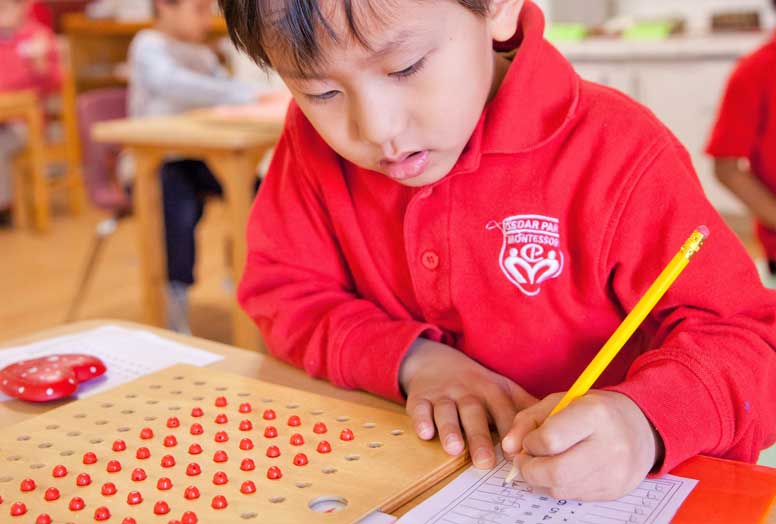
Montessori: Who can explain it please?
Wondering about Montessori teaching methods? Begin by watching this short video. It provides a useful overview of the philosophies at the heart of Montessori.
To be clear, Montessori is NOT a marketing label, a franchise, a religious denomination, the name of an organization or group, the latest trend, an esoteric doctrine or anything of that nature.
Montessori IS a scientifically-demonstrated method of child education. It was pioneered by Dr. Montessori, a three-time Noble-Prize-nominated Italian Doctor. Its primary focus is the comprehensive development of the child, including social, emotional, physical, spiritual and academic development.
Today, there are around 4,500 Montessori Schools in the US and over 20,000 worldwide — a stirring testament to this time-honored method of education.
Montessori schools and accreditations can vary widely. The difference centers largely on the scope and precision with which the expansive Montessori curriculum is administered by each school. Accreditation is the only way to guarantee that a Montessori school fully subscribes to the comprehensive Montessori Method.
The two primary bodies of this accreditation are the Association Montessori Internationale (AMI) — the original method with international accreditation, founded by Dr. Maria Montessori — and the American Montessori Society (AMS), a method derived from AMI and further adapted in the US decades ago.
What are the Key Tenets of the Method?
The Montessori Method is based on the following core principles:
- Respect for the Child: This principle allows the children a flexible scope with boundaries to creatively explore, discover and express their learning interests. In this way, and without inhibiting the child through a regimented approach, Montessori steers the child toward independence, self-confidence and a natural love of learning.
- An Absorbent Mind: A young child is naturally an enthusiastic and keenly curious learner, and can absorb a significant amount of information from its environment. Thus, the ages of 0-6 provides the opportune time to expose them to as much experiential, hands-on learning as possible.
- Sensitive Periods (stages or planes) of Development: A child’s growth takes place across four scientifically-based stages (or planes) of development and each of these stages demonstrates different needs within the learning cycle. Recognizing this, the Montessori educational approach imparted adapts accordingly to these stages.
- A Ready Environment: Here, the focus of learning is experiential and not based on memorization. A wide selection of specialized Montessori materials is employed to facilitate the child’s sensorial and abstract learning. Through the guidance of a certified teacher, these materials instruct the child in complex concepts while he/she enjoys their use and manipulation.
Mixed-aged classrooms augment a child’s development as they learn from one another and their environment. Older children learn basic leadership skills and younger children learn what’s achievable — not just from the teacher, but from their peers. - Discovery and Independence: This principle recognizes each child’s unique learning potential. Therefore, an individualized learning approach is followed in accordance with the child’s specific needs and readiness.
These methodical principles, applied over time, promote self-esteem, independence, exploration and creativity, all within a nurturing and serene environment where the child embraces a joy-filled love of learning.
Dr. Maria Montessori
Nominated three times for the Noble Peace Prize in 1949, 1950, and 1951, Dr. Maria Montessori was an education pioneer who established the Montessori Method. Born in Italy, she became the first woman doctor in that country. Shortly after, her desire to help children was so strong that she gave up her medical practice in order to work with children of working parents. There, she established what is now known as the Montessori Method (of education) and the first “Children’s House” (Casa de Bambini).
Dr. Maria Montessori, through her observations, realized that children learn to absorb their environment effortlessly. It was through these observations that specialized materials and equipment were designed so that children could do work without requiring much assistance from the adult. Throughout the years, many who studied under her made their own significant contributions to education and child psychology, including Anna Freud, Jean Piaget, Alfred Adler, and Erik Erikson.
She is credited with the development of the “open classroom”, individualized education, hands-on learning materials, teaching toys, child-size tables and chairs and systematic instruction. In the last 35 years, educators in Europe and North America have begun to recognize the consistency of the Montessori approach, based on extensive research about child development.
Throughout her career as an educator, Dr. Maria Montessori visited many countries, including her first visit to the United States in 1913. It was at this time that the Montessori Educational Association was founded in Washington, D.C. by Alexander Graham Bell and his wife Mabel. She had staunch supporters such as Thomas Edison and Helen Keller. In the years following, she traveled throughout Europe and Asia giving lectures and establishing Teacher Training Institutions. Dr. Montessori died in Noordwijk, Holland in 1952; yet her work lives on through the Association Montessori Internationale (AMI), and through the dedicated schools and Montessori organizations.
For additional information about Dr. Maria Montessori, her life work, the Association Montessori Internationale (AMI) and the Montessori Method of Education, please visit this link.

